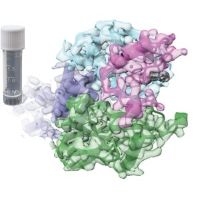Specification
| Description | Recombinant protein from the full-length sequence of homo sapiens major histocompatibility complex, class I, G (HLA-G-G) (NM_002127). |
| Organism | Homo sapiens (Human) |
| Expression Host | Human Cells |
| Tag Info | His or DYKDDDDK. Please contact us if you need further information or require specific designed tag. |
| Purity | Greater than 90% by SDS-PAGE gel |
| Uniprot ID | P17693 |
| Entry Name | HLAG_HUMAN |
| Gene Names | HLA-G HLA-6.0 HLAG |
| Alternative Gene Names | HLA-6.0 HLAG |
| Alternative Protein Names | HLA class I histocompatibility antigen, alpha chain G (HLA G antigen) (MHC class I antigen G) [Cleaved into: Soluble HLA class I histocompatibility antigen, alpha chain G (sHLA-G)] |
| Application | Antigens, Western, ELISA and other in vitro binding or in vivo functional assays, and protein-protein interaction studies; For research & development use only! |
| Buffer | Purified protein formulated in a sterile solution of PBS buffer, pH7.2, without any preservatives |
| Endotoxin | Endotoxin level is < 0.1 ng/µg of protein (<1EU /µg) |
| Length | 338 |
| Molecular Weight(Da) | 38224 |
| Protein Sequence | (The sequence of expressed protein may have some variation from the sequence shown below. Please contact us for the exact sequence.) MVVMAPRTLFLLLSGALTLTETWAGSHSMRYFSAAVSRPGRGEPRFIAMGYVDDTQFVRFDSDSACPRMEPRAPWVEQEGPEYWEEETRNTKAHAQTDRMNLQTLRGYYNQSEASSHTLQWMIGCDLGSDGRLLRGYEQYAYDGKDYLALNEDLRSWTAADTAAQISKRKCEAANVAEQRRAYLEGTCVEWLHRYLENGKEMLQRADPPKTHVTHHPVFDYEATLRCWALGFYPAEIILTWQRDGEDQTQDVELVETRPAGDGTFQKWAAVVVPSGEEQRYTCHVQHEGLPEPLMLRWKQSSLPTIPIMGIVAGLVVLAAVVTGAAVAAVLWRKKSSD |
Background
| Function | FUNCTION: [Isoform 1]: Non-classical major histocompatibility class Ib molecule involved in immune regulatory processes at the maternal-fetal interface (PubMed:23184984, PubMed:29262349, PubMed:19304799). In complex with B2M/beta-2 microglobulin binds a limited repertoire of nonamer self-peptides derived from intracellular proteins including histones and ribosomal proteins (PubMed:7584149, PubMed:8805247). Peptide-bound HLA-G-B2M complex acts as a ligand for inhibitory/activating KIR2DL4, LILRB1 and LILRB2 receptors on uterine immune cells to promote fetal development while maintaining maternal-fetal tolerance (PubMed:23184984, PubMed:29262349, PubMed:16366734, PubMed:19304799, PubMed:20448110, PubMed:27859042). Upon interaction with KIR2DL4 and LILRB1 receptors on decidual NK cells, it triggers NK cell senescence-associated secretory phenotype as a molecular switch to promote vascular remodeling and fetal growth in early pregnancy (PubMed:23184984, PubMed:29262349, PubMed:16366734, PubMed:19304799). Through interaction with KIR2DL4 receptor on decidual macrophages induces proinflammatory cytokine production mainly associated with tissue remodeling (PubMed:19304799). Through interaction with LILRB2 receptor triggers differentiation of type 1 regulatory T cells and myeloid-derived suppressor cells, both of which actively maintain maternal-fetal tolerance (PubMed:20448110, PubMed:27859042). May play a role in balancing tolerance and antiviral-immunity at maternal-fetal interface by keeping in check the effector functions of NK, CD8+ T cells and B cells (PubMed:10190900, PubMed:11290782, PubMed:24453251). Reprograms B cells toward an immune suppressive phenotype via LILRB1 (PubMed:24453251). May induce immune activation/suppression via intercellular membrane transfer (trogocytosis), likely enabling interaction with KIR2DL4, which resides mostly in endosomes (PubMed:20179272, PubMed:26460007). Through interaction with the inhibitory receptor CD160 on endothelial cells may control angiogenesis in immune privileged sites (PubMed:16809620). {ECO:0000269|PubMed:10190900, ECO:0000269|PubMed:11290782, ECO:0000269|PubMed:16366734, ECO:0000269|PubMed:16809620, ECO:0000269|PubMed:19304799, ECO:0000269|PubMed:20179272, ECO:0000269|PubMed:20448110, ECO:0000269|PubMed:23184984, ECO:0000269|PubMed:24453251, ECO:0000269|PubMed:26460007, ECO:0000269|PubMed:27859042, ECO:0000269|PubMed:29262349, ECO:0000269|PubMed:7584149, ECO:0000269|PubMed:8805247}.; FUNCTION: [Isoform 2]: Likely does not bind B2M and presents peptides. Negatively regulates NK cell- and CD8+ T cell-mediated cytotoxicity (PubMed:11290782). {ECO:0000269|PubMed:11290782, ECO:0000305}.; FUNCTION: [Isoform 3]: Likely does not bind B2M and presents peptides. Negatively regulates NK cell- and CD8+ T cell-mediated cytotoxicity (PubMed:11290782). {ECO:0000269|PubMed:11290782, ECO:0000305}.; FUNCTION: [Isoform 4]: Likely does not bind B2M and presents peptides. Negatively regulates NK cell- and CD8+ T cell-mediated cytotoxicity (PubMed:11290782). {ECO:0000269|PubMed:11290782, ECO:0000305}.; FUNCTION: [Isoform 5]: Non-classical major histocompatibility class Ib molecule involved in immune regulatory processes at the maternal-fetal interface (PubMed:23184984, PubMed:29262349, PubMed:19304799). In complex with B2M/beta-2 microglobulin binds a limited repertoire of nonamer self-peptides derived from intracellular proteins including histones and ribosomal proteins (PubMed:7584149, PubMed:8805247). Peptide-bound HLA-G-B2M complex acts as a ligand for inhibitory/activating KIR2DL4, LILRB1 and LILRB2 receptors on uterine immune cells to promote fetal development while maintaining maternal-fetal tolerance (PubMed:23184984, PubMed:29262349, PubMed:16366734, PubMed:19304799, PubMed:20448110). Upon interaction with KIR2DL4 and LILRB1 receptors on decidual NK cells, it triggers NK cell senescence-associated secretory phenotype as a molecular switch to promote vascular remodeling and fetal growth in early pregnancy (PubMed:23184984, PubMed:29262349, PubMed:16366734, PubMed:19304799). Through interaction with KIR2DL4 receptor on decidual macrophages induces proinflammatory cytokine production mainly associated with tissue remodeling (PubMed:19304799). Through interaction with LILRB2 receptor triggers differentiation of type 1 regulatory T cells and myeloid-derived suppressor cells, both of which actively maintain maternal-fetal tolerance (PubMed:20448110). Reprograms B cells toward an immune suppressive phenotype via LILRB1 (PubMed:24453251). {ECO:0000269|PubMed:16366734, ECO:0000269|PubMed:19304799, ECO:0000269|PubMed:20448110, ECO:0000269|PubMed:23184984, ECO:0000269|PubMed:24453251, ECO:0000269|PubMed:29262349, ECO:0000269|PubMed:7584149, ECO:0000269|PubMed:8805247}.; FUNCTION: [Isoform 6]: Likely does not bind B2M and presents peptides. {ECO:0000305}.; FUNCTION: [Isoform 7]: Likely does not bind B2M and presents peptides. {ECO:0000305}. |
| Pathway | |
| Protein Families | MHC class I family |
| Tissue Specificity | Expressed in adult eye (PubMed:1570318). Expressed in immune cell subsets including monocytes, myeloid and plasmacytoid dendritic cells and regulatory T cells (Tr1)(at protein level) (PubMed:20448110). Secreted by follicular dendritic cell and follicular helper T cells (PubMed:24453251). Isoform 5: Detected in physiological fluids including amniotic fluid and serum (PubMed:11137219). Isoform 7: Expressed in placenta, amniotic membrane, skin cord blood and peripheral blood mononuclear cells (PubMed:11137219). {ECO:0000269|PubMed:11137219, ECO:0000269|PubMed:1570318, ECO:0000269|PubMed:16210391, ECO:0000269|PubMed:20448110, ECO:0000269|PubMed:24453251, ECO:0000269|PubMed:26460007, ECO:0000269|PubMed:7589701}. |
QC Data
| Note | Please contact us for QC Data |
| Product Image (Reference Only) |  |

